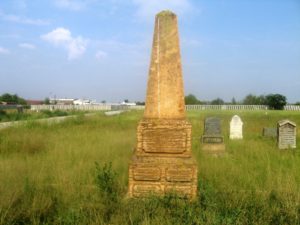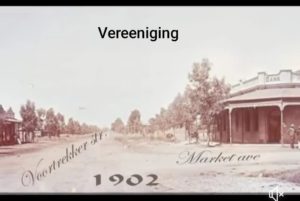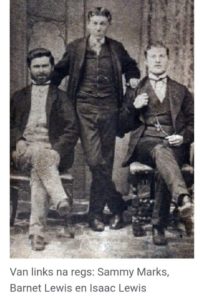VEREENIGING
MYNONGELUK BY CENTRAL MINE
25 Mei 1905
VEREENIGING
Die dorp Vereeniging het sy naam verkry vanaf die laaste deel van een van die pioniersmaatskappye “ De Zuid Afrikaansche en Oranje Vrij Staatsche Kolen en Mineralen Mijn Vereeniging”, gestig deur Lewis and Sammy Marks.
STEENKOOL MYNE
George William Stow het
steenkool in hierdie area weerskante van die Vaalrivier ontdek en die wakker sakeman Sammy Marks het dadelik die potensiaal van die ontdekking besef en die bogenoemde maatskappy gestig .
Hierdie maatskappy het in 1882 aansoek gedoen om ‘n nedersetting op te rig op die plaas “Leeuwkuil”. Die aansoek is eers in 1889 goedgekeur, 1892 is die eerste erwe van Vereeniging per publieke veiling in Johannesburg verkoop en dit was die begin van die dorp Vereeniging.
Die ontstaan en groei van Vereeniging is te danke aan die diamantmyne in Kimberley.
Die maatskappy van Marks en Lewis , “ De Zuid Afrikaansche en Oranje Vrij Staatsche Kolen en Mineralen Mijn Vereeniging”, het kole as brandstof aan die myners in Kimberley verskaf.
Toe die inheemse bosse in Kimberley se omgewing uitgekap en brandhout skaars geword het, het die aanvraag na steenkool uit Vereeniging toegeneem. Dit het die mynbou bedrywighede in Vereeniging ‘n goeie hupstoot gegee.
Die ontdekking van goud aan die Witwatersrand het ook bygedra tot die snelle ontwikkeling van mynbou in Vereeniging.
Central Colliery het gou ontwikkel as een van die grootste steenkoolmyne in Afrika.
Daar was/is verskeie steenkoolmyne reg rondom Vereeniging.
Vereeniging is vandag nog bekend daarvoor dat ‘n lagie fyn swart stof alles in die dorp en omgewing bedek.
CENTRAL MINE
Stow se eerste primitiewe mynbedrywighede het op die plaas Leeuwkuil begin. Hierdie ou skag het later deel van die Bedworth Steenkoolmyn geword.
Central Mine was een van die eerste myne wat ontwikkel is.
Hierdie myn het baie probleme met veral hoë konsentrasies gasse gehad.
Aanvanklik was meeste werkers en veral die mynbestuur immigrante, meeste afkomstig uit Engeland.
DIE JARE NA DIE ABO
In die jare na die Anglo-Boereoorlog het die meeste van die inwoners van Vereeniging in Central Mine gewerk of by die aangrensende steengroef gewerk.
Plase was afgebrand en verwoes deur die Britte se Verskroeide Aarde Beleid tydens die ABO en arm boere het hoopvol na die oorlog na Vereeniging gestroom om werk en ñ heenkome te probeer vind.
ONGELUK BY DIE CENTRAL MINE
Mynongeluk by Central Mine 1905
1900. Vereeniging was nog ‘n klein dorpie. Byna die helfte van die inwoners het in die steenkoolmyn (Central Mine) gewerk.
Vroeg 1905 het daar ‘n groot krisis in Vereeniging ontstaan toe die steenkoolrif by die Jubilee skag aan die westekant van die Central Mine doodgeloop het en alle ondergrondse werk daar gestaak is.
Mettertyd het die dak van die myn daar ingestort en daardie deel van die myn was vergete tot Mei 1905.
25 Mei 1905 was daar ñ spontane ontploffing in hierdie verlate deel van die myn en gevaarlike gasse het gou versprei na die res van die Central Mine.
Heelwat werkers was oorval, blank sowel as swart. Alle bedrywighede in die myn is gestaak vir die dag.
Die oggend na die ontploffing is die mynbestuurder en 5 senior beamptes ondergronds om te gaan ondersoek instel. In die flou lig van hulle veiligheidslampies het hulle die donkerte aangedurf terwyl hulle sakdoeke voor hulle neuse gehou het.
Dwarrelende gas het hulle onverwags oorval en een vir een het hulle inmekaargestort en gesterf.
Vrywillige reddingswerkers het desperaat probeer help in die digte rook maar hierdie heldedaad het net nog meer lewensverlies tot gevolg gehad.
Tien (10) witmense en sewe (7) swart mense se lyke is uiteindelik na die oppervlak toe gebring.
GEDENKSTEEN IN VEREENIGING KONSENTRASIEKAMP BEGRAAFPLAAS
‘n Gedenksteen is opgerig ter herinnering aan die manne wat in hierdie ongeluk gesterf het.
“This monument records the heroism of
Andrew Fraser Ross & David Thomas Price
Who lost their lives in a noble attempt to rescue
Henry Brocklesby Bunkell, Thomas William Davis, William OwenJones, & Walter Brown, who also perished in a fire in the Central Colliery,
Vereeniging, on the 25tj May, 1905.”
Onder op die sandsteen monument.word ook die name aangedui van:
1. William Owen Jones
(Mine Manager)
Of Aberporth, Cardiganshire, Wales,
Aged 40 years.
2. Walter Brown,
(Mine Captain)
Of Lochgelly, Fifeshire, Scotland,
Aged 36 years.
3. Andrew Fraser Ross,
(Surface Overseer)
Of Aberdeen, Scotland,
Aged 39 years.
4. David Thomas Price,
(Miner)
Of Georgetown, Mon, Wales
Aged 31 years.
Andrew Fraser ROSS & David Thomas PRICE, William Owen JONES en Walter BROWN begrawe by die Gedenksteen
Henry Brocklesby BUNKELL enThomas William DAVIS op versoek van die familie begrawe in Braamfontein Begraafplaas Johannesburg
1917: CENTRAL MINE ONTPLOF
Interessant, die steenkool in die myn het bly brand tot 1917, byna ‘n dekade lank.
In 1917 was die Vaalrivier in vloed, die walle het oorstroom en water het in die verlate myn (Central Mine) ingestroom.
Die water het ook in die brandende Jubilee seksie ingestroom.
Die opbou van stoom ondergronds het ‘n reuse ontploffing tot gevolg gehad en byna die hele myn het ontplof en inmekaar gestort. Stoom het hoog in die lug opgeskiet uit die ou myn uit.
Vandag is daar net ‘n baie diep blou gat vol water, opgestote grondbanke en half weggewerkte mynhope as stille getuienis van die eens florende myn en die groot ramp wat daar plaasgevind het.
Die “Blou gat” was in die verlede ‘n gewilde plek om te besoek en die dorp se seuns het hier lekker visgevang.
Waaghalse het ook gereeld met hulle viertrekvoertuie en motorfietse die steil hellings aangedurf.
Ongelukkig is hierdie verlate area (Spidervalley) nou ‘n baie onveilige plek om te besoek.
Kriminele elemente het sedertdien hier oorgeneem. (2022)
Samesteller: Kobie Ströh
Bronne: http://monument-sa.co.za/vereeniging-geskiedenis/ en
Facebook Sarel Feldtmann
Foto’s: Vaaldriehoek Kultuurnetwerk 2023, Gys Ströh snr Junie 2023
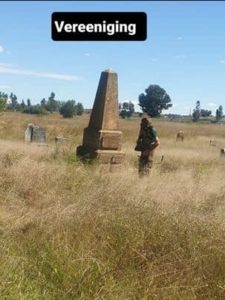
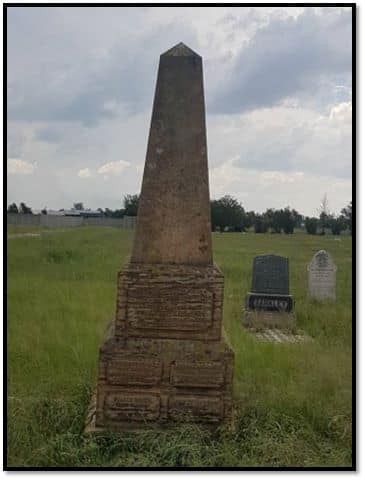
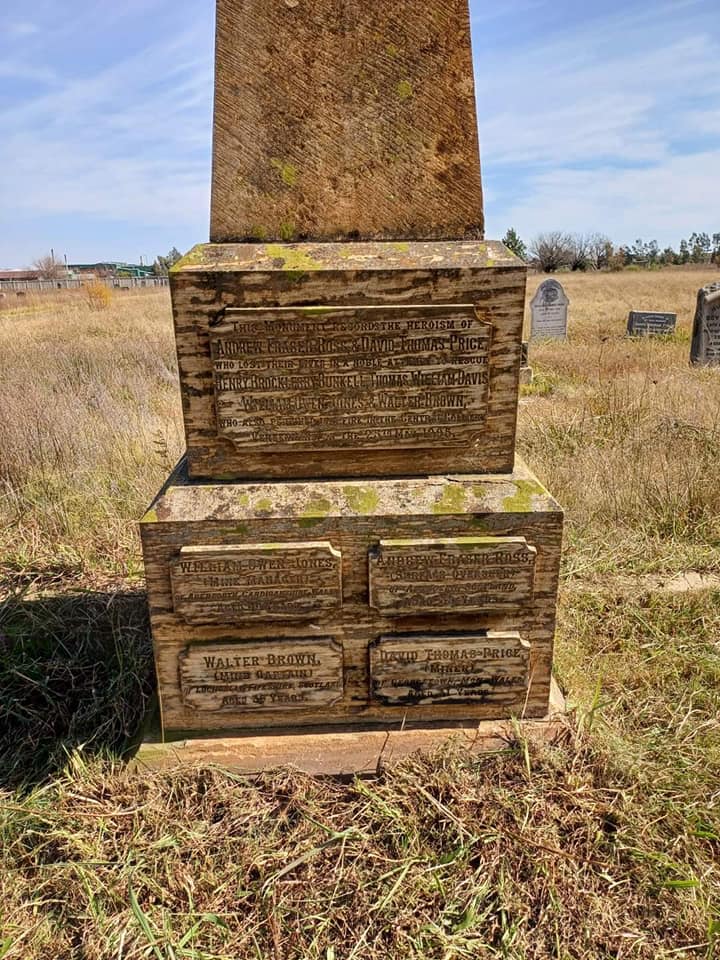
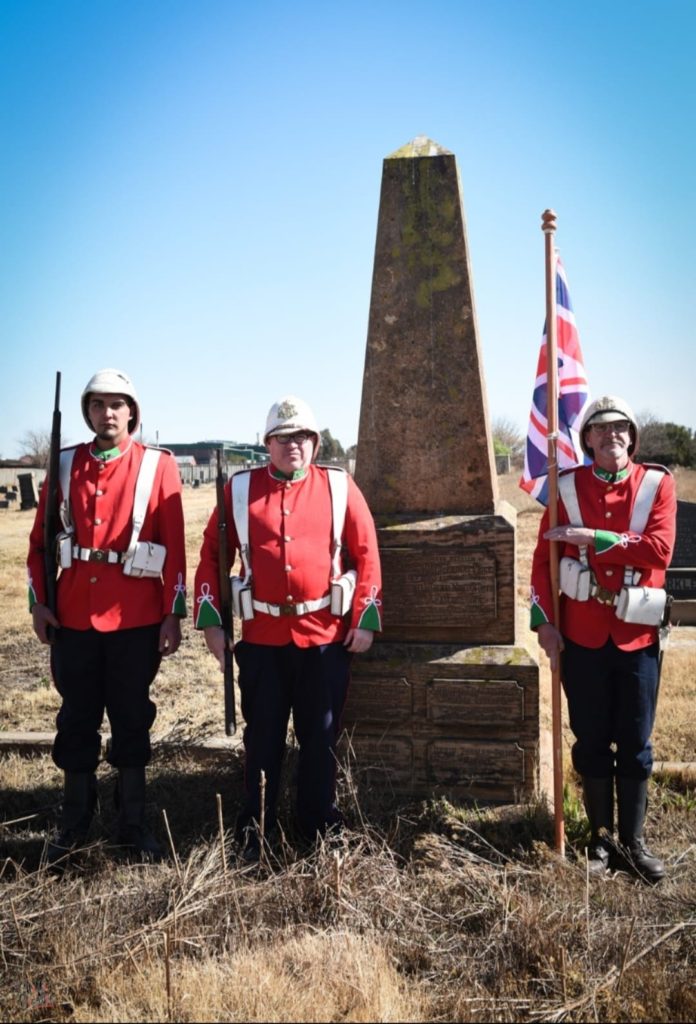
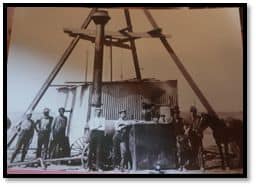
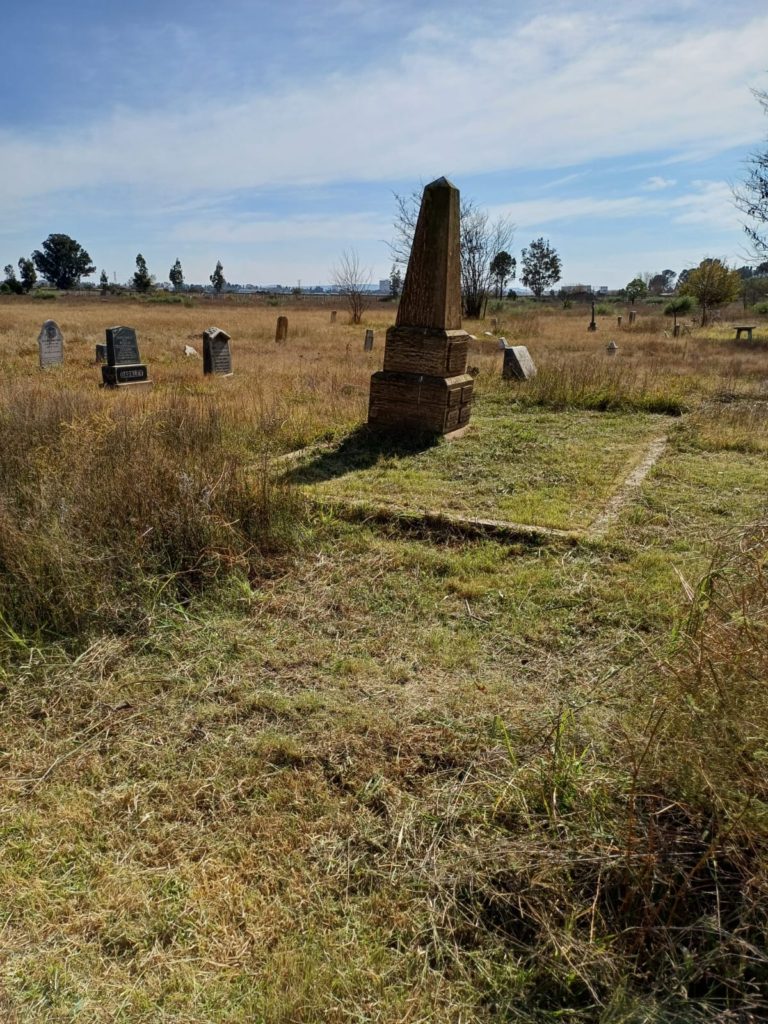
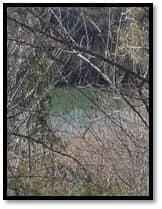
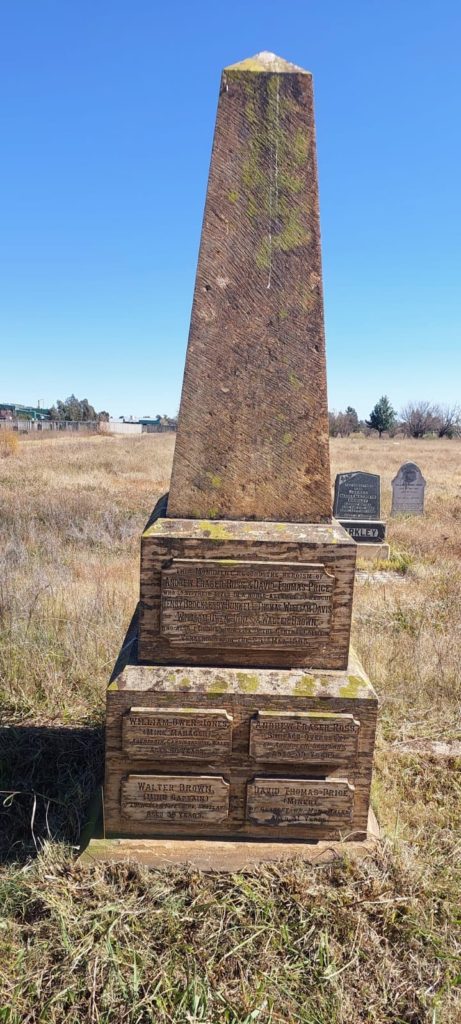

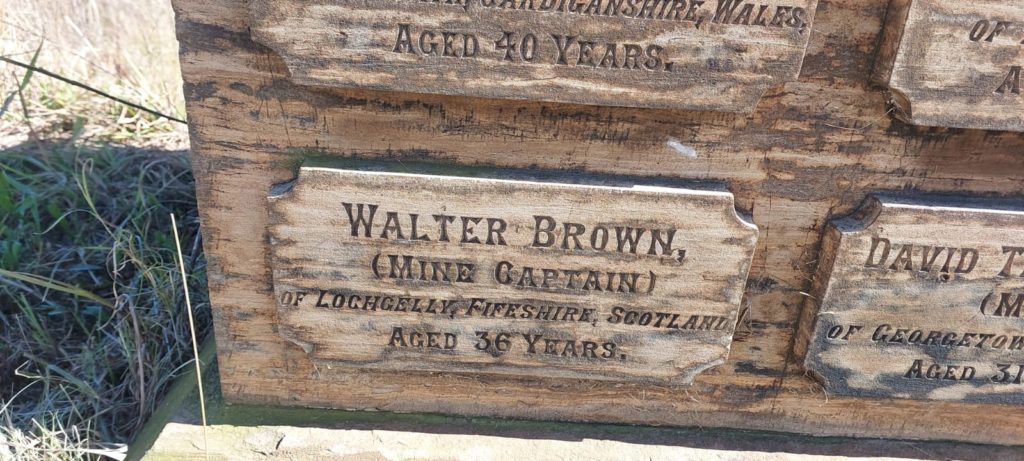
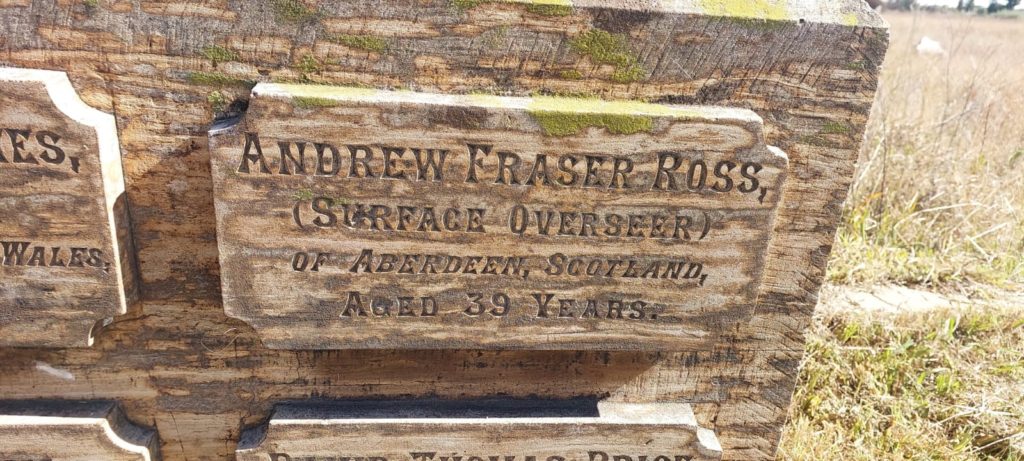
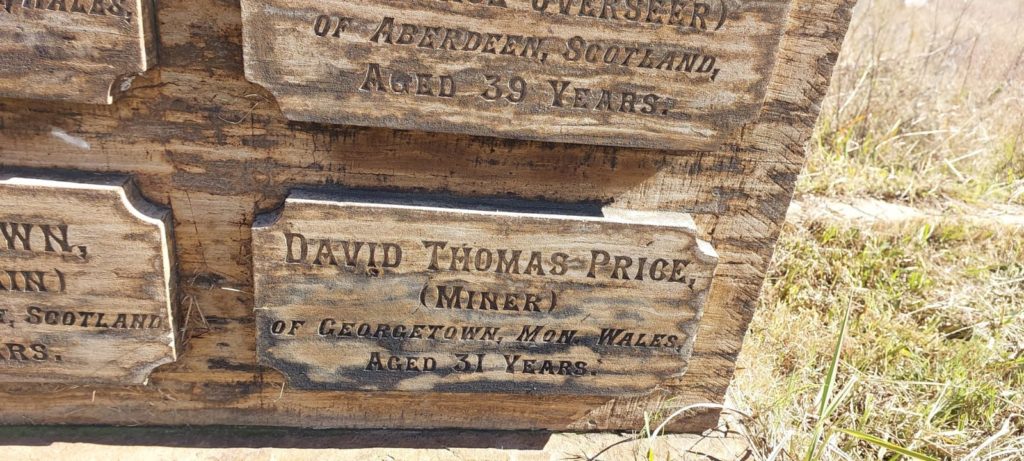
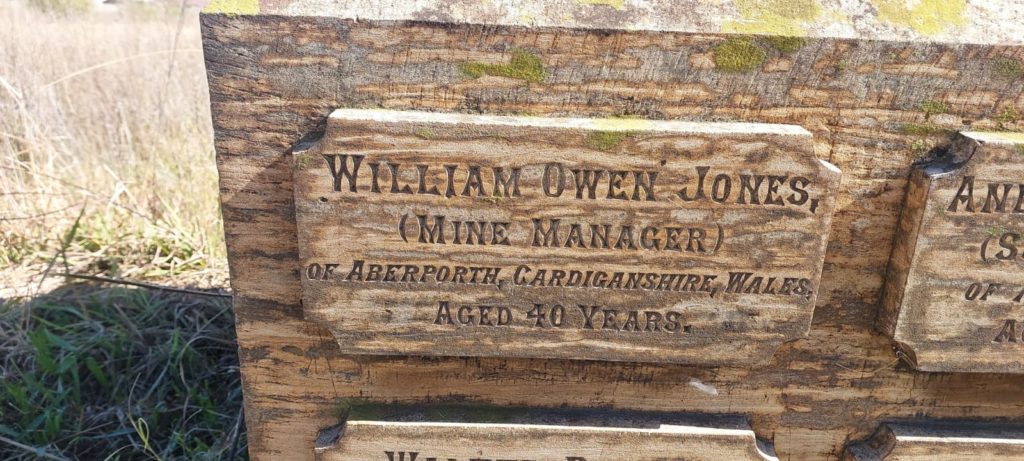
Inligting verskaf deur Chris Doughty:
As a bit of background, I spent my childhood in South Africa (in Johannesburg) and Rhodesia (in Salisbury) and immigrated to South Australia when I was 13 years of age in 1961.
My grandfather on my mothers side was born in South Africa and it was his father, Andrew Fraser Ross who was killed in the mine disaster, we were not aware of the full story and the existence of the memorial in the cemetery in Vereeniging.
It was only about 15 years ago that we started to piece together the information and found various documents and photos, including a copy of the Johannesburg Star with an article about the coronial inquest into the disaster. We have transcribed this article and I have included a copy for your information.
I have also attached photos of Andrew Fraser Ross who married a mixed race lady (Catherine Wessels). I have also included a collage of photos of the monument over the years from 1905 when the bodies were buried there.
THE STAR WEEKLY EDITION, JOHANNESBURG, SATURDAY, JUNE 8, 1905
The Vereeniging Disaster – Recovering the Bodies.
On inquiry at the office of Messrs.Lewis and Marks this morning, we were informed that the efforts
to recover the bodies of Messrs. Bunkell (consulting engineer), T. W. Davis (assistant engineer), W.O.
Jones (manager), and W. Brown (underground manager), had not been successful. The position in
which the bodies are known to be lying indicates that the poisonous gas to which the victims of the
disaster succumbed was generated not by a fire which has been known for some time to exist in
some old workings, but by combustion, probably of recent origin, in another part of the mine, which
has had to be abandoned owing to the subsidence of the roof and walls.
Later – The bodies of Messrs. Bunkell, Davvies, Owen Jones and Brown were recovered this
afternoon and those of the former two are being conveyed to Johannesburg, and will arrive there
about 6.30.
The funeral cortege of Messrs. Ross and Price left the mine at 2 o’clock for the interment in
Vereeniging cemetery. Although the weather was very inclement, there was a very large attendance
of the public to testify their admiration of the heroic action of the deceased, and sympathy with
their relatives. Most of the leading residents, including the Magistrate and mine officials, attended.
A large number of wreaths was sent.
The Official Narrative.
The following is the report of the Inspector of Mines regarding the accident at Vereeniging.
The following telegram and letter were received from the Manager of the Vereeniging Estates and
Mines:- “Regret having to report outburst of fire in the old western section of the Central Mine on
Thursday, 25th.” On Friday morning, the 26th inst., I sent a telegram to the manager asking for further
particulars, and received reply at 11.45 a.m. that “Manager and consulting engineer and four other
white men and two natives killed by gas and bodies not recovered.” I immediately replied “Coming
down by first train leaving about 12 noon.”
The manager reported as follows on May 25:- Henry Brocklesby Bunkell, Wm. Owen Jones, Thos.
Wm. Davies, Walter Brown, Andrew Fraser Ross, Thomas Price, natives Fifteen. No. 1,156, and M
Sight, No. 563. Asphyxiation by foul gas. All killed. Fire in mine workings. Accidental. Thos. Spittle, —
-lded
(Unreadable ——— fold in paper)
explained the situation and what was being done. I then went down the mine and found the work
under the charge of William Lewis, the manager of the Great Eastern Colliery, Springs, who had
come down early on Friday morning and was engaged in directing operations underground to
recover the bodies of those lost.
In consultation, he described what had taken place, what he found on his arrival, and what he had
done to ensure the future safety of those employed in exploring work.
I found all the old shafts, air winzes, etc., were closed, excepting No. 3 shaft which was in close
proximity of the fire, and the main incline shaft. On the top of No. 3 shaft they had placed a large
“Sirocca” fan, driven by a portable engine, and exhausting about 20,000 cubic feet per minute from
the mine.
The main incline shaft was then acting as a downcast, conveying a good volume of air, which was
partially directed towards where the explorers were working. They were trying to get up the old
main west drive, known as No. 3 road, which is in direct line with the No. 3 shaft, wherein the bodies
were supposed to be lying, or near thereto. I found men placed every few yards apart within easy
call of each other, whilst the forward gang were advancing slowly. I found them stopped owing to
the presence of “carbon monoxide,” and waiting for a hand fan and pipes, which arrived, but were
found to have no impression on the gas. I then pointed out that the large number of men with all
the candles burning was really doing no good and that all the men and boys must go out of the mine,
and that a fresh gang be got together and do nothing else but fix up canvas barattice stopping all the
way from the incline shaft bottom, as far as the west drive as they could possibly go. This was
immediately taken in hand. Canvas, sail cloth and sacks were at once obtained and the work started,
also a small electric fan was being overhauled. The canvas stoppings were completed by 12 noon on
Saturday, also the electric fan set going. The whole approach up the drive was clear of gas, and a fair
current of air passing up. Within two pillars of No. 3 shaft. In a south drive, the bodies were found.
We had them immediately conveyed to the shaft, where the coffins were in readiness, and
everything was completed in the presence of the chairman, Mr. De Jongh, the magistrate, (Mr.
Cochran), the District Surgeon (Dr,. Curry) in whose presence the bodies were all identified. Only
one gang of men was left in the mine to remove the material, fan, etc.
THE EVIDENCE.
I then proceeded to take the following evidence:
James Hunter, manager Cornelia Coll. Stated: On the 24th inst. I heard of a fire at Central Mine,
Vereeniging. I came over at 11 a.m. I met Mr. Jones, the manager, who pointed out the locality of
the underground fire, on the surface as well as on the mine plan. The mine was not working. We
consulted as to the ventilation of the mine and the closing down of the numerous shafts on the
north and west side of the mine. About 2 p.m., a party of Mr. Jones, Mr. Torrance, Mr. Leslie, some
workmen and myself went down the incline shaft and examined the air as we proceeded towards
the No. 3 shaft, and found it a strong downcast good air. We went southwest to the fire at No. 3
shaft, no sign of gas. I saw the fire; it would be alight about 40 feet and about 6 feet in height, We
found the roof fallen and the roof upheaved in different parts. We then came down passing No. 8,
to the incline shaft south drive, and came out. We went to the top of No. 3 to measure the depth of
the shaft, we tried with a small lamp to see if there was any current and found none. The depth was
52 feet 6 inches. We went around the other shafts and found them mostly upcasts. We started to
cover over with sacks and iron some of the shafts tops. We got seven covered over, leaving No. 3
and No. 8, which were near to the fire, open to act as upcasts. Mr. Jones informed me that he had
sent for the copperting engineer and would do nothing until he arrived. I was sent for on Thursday,
about 1.30 p.m., to come over at once and that Mesars. Jones, Bunkell, Davies and Brown who had
gone down the mine, were reported lost. I came over at once, after closing down the Cornelia mine,
and brought all my white employees. I got over at about 2 .p.m. I found that a party of explorers
had gone down for the missing men. I got a party together and went down the incline shaft,
proceeded south as far as No. 8 drive, found the air fresh and good and no indication of gas. Part of
the first relief party I found stationed along the road, who informed me that two white men and a
native were lying gassed near to No. 8 shaft. I then heard groaning, and cautiously moved forward,
testing for gas. About 50 feet west of No. 8 shaft I found a workman, “Vincent,”” lying gassed: we
carried him out to a bearer party who carried him to the shaft tip. We advanced ahead and found
“Sinkerson” about 50 yards beyond No. 8 shaft, we got him out and then we went forward and
found a native gassed; we brought him out and he recovered. The other relief party reported Price
and Ross and two natives lying further west. As the gas was bad and we were feeling the effects we
could not proceed. We came back into the fresh air and after a rest I interviewed Sinkerson, who
had recovered from the gassing. He then informed me as to the localities of the bodies of Ross and
Price, who he thought were dead. I went down with a relief party to No. 8 and proceeded in West
130 yards and found the body of Price, dead. About fifty yards further I found Ross lying on a
stretcher with two natives lying dead. We had to go back owing to the gas. We halted at No. 8 and
then again went in
(Unreadable ———- fold in paper)
Cope No. 8 and incline shaft. At No. 3 we had a sirocco fan, with traction engine driving it. Placed
and started, exhausting the air out. I handed the charge over to Mr. Lewis I did not go down until 8
p.m. o Friday night, to fix up bratticing in all the openings going down No. 3 drive, which we
completed by 6 a.m. About 11.30 a.m., we heard a heavy noise in the south direction, which we
concluded to be a fall in the workings. It drove gas out on to the drive and caused us to retire. The
air recovering, we went back again, and proceeded with the bratticing up to 4.30 a.m., when another
fall took place and drove us out. We got in again and completed the brattice within 20 yards of the
No. 3 shaft. The air was good and fresh. I searched the pillar on the north and south of the drive for
four pillars, and found a fall 130 yards, but could not find the bodies. I was relieved then by Mr.
Lewis about 7 a.m. I went down with Mr. Lewis and showed him how far we had got on and the
parts we had searched, and found the gas was getting denser. Then I came out of the mine.
Arthur Henry Smith, compound manager, Vereeniging Estates, stated: – On Monday the 22nd
instant, about 5 p.m., a native constable “Side,” came up for a stretcher to bring a native, who had
been gassed, back to the compound, and a native slightly gassed. This was the first intimation of any
gas or fire I had in the mine. On Tuesday the 23rd, about 1.30 p.m., a note came to me from Brown,
the mine captain, that four natives working at the bottom of the incline were absent. I went around
the huts and found the boys were not in a fit condition to go to work, as they were under the
influence of gas. I met Mr. Jones about 2.30 p.m., and reported that there must be some foul air at
the bottom of the incline. Mr. Jones said, “Oh! I will go down at once and see about it. “ About 4.30
p.m., the doctor was in my office when I received a message that several boys were being brought
out of the mine “gassed.” We went over and found the natives being brought out. They were
attended to and recovered. On Tuesday night the manager and party were trying to find out where
the gas was coming from, and also to locate the fire. At 5 a.m. on Wednesday the 24th, I received the
signal, “No work.” I turned out a few boys, not exceeding about 60, for the surface. They were
engaged in moving the portable engine and fan to No. 3 shaft. On Thursday morning, about 5.15, I
got work “No work;” no reason was given. About 9 a.m., Mr Bunkell and Mr. Davies came on to the
property. I saw them at the shaft about 10 a.m. About 11.50 I was at the shaft and was told that
Messrs. Jones, Brown, Davies and Bunkell had gone underground. About 12 noon, I was walking
over to the No. 3 shaft, when I met Hill and Saunders, who reported that Mr. Brown had shouted up
the shaft that all was right and that Price and Sharp should come down No. 3 shaft, and they were
lowered to clear away the opening at the bottom. About 1 p.m., I saw Moreland and party going to
the shaft. They thought something had gone wrong with the manager’s party and proceeded
underground. I met the other party of Ross and Price coming from lunch, and told them something
was wrong and those men had not returned. About 1.30pm, I got the timekeeper and Blockson and
went down the incline and into the west shaft drive and met Moreland and party, who reported that
the dead bodies had been seen. I came up and reported the matter to Mr Torrance at the office. I
went down again and came out again at 3.0 p.m. Mr. Torrance gave me orders to turn out boys to
open shafts. I went down again and found my constable “gassed.” I got more boys out. Mr. Hunter,
from the “Carnelia” came over and we tried to get in. We found Ross and Price close to No. 6 shaft
where we met gas and were driven back. On Friday morning Lewis came and took charge.
David Pollock sharp, miner, stated:- I was working in the north district on Tuesday. None of
my goys were ”gassed.” On Wednesday the mine did not work. I did not know what was wrong. But
I knew there was gas in the mine from a fire, but did not know in what direction it was coming from.
We went down about 10 a.m., and found the front of the fire near No. 3 shaft, where there is a large
fall of about 12 yards; this was burning in the shale and top seam. We all came out. I then started
covering all the tops of the old shafts except No. 3 and No. 8. On Thursday morning we were waiting
for the consulting engineer to come. We fixed a windlass at No. 3 and No. 8. We fixed a windlass at
No. 3 and when finished, about 1 p.m., Mr. Jones went down in the bucket, and found the bottom
had broken into the fall where the fire was. We pulled him up again. About 10 a.m. Mr. Jones and
party went down the incline. They instructed Price, Sinkerton, Stephens and me to go to No. 3 and
wait until they came to the bottom. About 10.30 they called up the shaft. Jones called for me to go
down. I descended in the bucket, and met Mr. Jones and then the other three. We opened out the
bottom so that I crept through to them. Mr. jones told me to pack a wall with stones, so as to get
the ventilation to work up the shaft, as he intended putting up a fan on the top. Mr Jones and
Bunkell came up the fall to the shaft, and called to Brown and Davies if they were all right; they
answered “Yes,” After telling me to get on with the wall, Mr. Bunkell said, “Jones, let us get back
over the fall again.” They went away, and this was the last I saw of them. It was 10.40 a.m. I moved
stones up to 12 noon, when I went out. I went to dinner, and then back to the incline at 12.45, and
found they had not come up. I got a party – Moreland, Barnes, and Hill – and went down and up
the front of the fire and could not find them. We went to No. 3 shaft bottom and could not see
them, and on our way back, about 50 yards to our left we saw them all laying down. I went
(Unreadable ———- fold in paper)
James Sinkinson, miner, stated: On Thursday, about 78 a.m., I was along with Sharp at No. 3
shaft. I saw Mr. Jones being lowered and examining the shaft. About 10 a.m. we came back to No.
3 shaft. I saw the manager and party go down the incline. I was at No. 3 shaft about 10.40, and
when Jones called up for a man to go down the incline (I was at No. 3 shaft), Sharp got into the
bucket and was lowered. I heard them talking; then Sharp called for Price to go down. He went to
help Sharp to clear the bottom. At 12 noon they came up and we went to lunch. About 1 p.m. we
found the party was missing. I went down the incline with Sharp. We went to No. 3 shaft. Around
the fire Sharp went forward and then came and called us back. He was gassed we carried him out to
the incline shaft. About 2 p.m. I joined Ross and Price, with four natives, and went up No. 8 road to
the No. 3 fall, when we got into the gas. Ross and Price were leading when Ross fell. We had got
him out a short distance when I was overcome by the gas and fell, and I do not know any more.
Charles Henry Lock, in charge of the Central East Mine, stated: On Thursday about 2 p.m., I
was with the party of Sinkinson, Price, and Ross. Ross, Price and I were together heading the party.
We went up No. 3 road as far as No. 3 fall, where we found the gas very strong. Ross and Price both
fell. I saw them fall and then was overcome myself and fell, but managed to creep out to Sinkinson
and the natives. I told Sinkinson to go and get Ross And Price out. I did not know any more until I
recovered at the incline shaft.
James Leslie Morland, engineer, stated: On Thursday, at 1 p.m., after lunch, I sent round to
find out if the manager and his party had come out of the mine. Not finding them, I got Sharp and
others together and descended the incline shaft to search for them. We went up the stable road to
No. 3 shaft. We make arrangements as to returning within three-quarters of an hour. Sharp,
Bernes, Hill and myself were the advance party. We got up to the fire and went round it to No. 3
shaft and then back to the fire. We saw the chalk mark upon the wall, and came to two pillars back
south towards No. 8, where we found Mr. Jones and Mr. Davies, and lying about two yards away
were Mr. Bunkell and Mr. Brown. We found that we could not stand the gas, and then returned to
the incline shaft, where I was overcome and carried out. On Thursday afternoon I heard that Ross
and Price and two natives had been overcome in the No. 8 drive. I joined Hunter’s party and went to
No. 8 drive. About 40 yards past the shaft we came across Price, dead, about 30 yards further, Ross,
with two natives dead. We then went back to No. 8 shaft, as the gas was bad, and then rested.
Then went in again after passing Price and picked up Ross and carried him back about 60 yards,
when we were overcome and had to leave the bodies.
On Friday, about 11.30 a.m., I joined Mr. Lewis’s party and we went up No. 8 drive, past the
shaft and picked up the four bodies and brought them out.
William Lewis, manager, Great Eastern Coliery, stated: On Thursday, the 25th, I came to
Vereeniging at 1 a.m. with the directors, who handed over the charge of the colliery to me. I found
from the officials that one portion of the mine was on fire, and that the consulting engineer,
manager, surveyor, mine overseer, had descended the mine and had been killed by the gases from
the fire that an exploring party had located the bodies, but owing to the excessive amount of gas
present, found it impossible to remove them. I found the main incline shaft acting as an upcast, and
gas prevalent at the bottom station, so that it was impossible to descent or get into the workings. I
then obtained a traction engine and a “Sirooco” fan, fixed it on top of the No. 3 shaft and started it
going. The other shaft tops were covered over. I then found the incline shaft clear of gas, with a
little downward current of air passing. About 11 a.m. on Friday I organised relief gangs for exploring
the mine. I descended the shaft and entered the south drive, which was gradually being cleared of
gas, and the fresh air following us in. About 12 noon I went over towards No. 8 drive, which I found
clear of gas, went forward to No. 8 shaft and found the bodies of two white men, Ross and Price,
also two natives, all dead. I got them out and sent to the surface. By 2 p.m. I got to within 50 yards
of where the other bodies were supposed to be lying, but owing to the excessive amount of gas still
being present; I decided to have a hand fan and pipes fixed, also an electric fan. After a time, finding
that little impression was being made on the gas in the drive, I decided to withdraw all the men
from the front and started a fresh gang of carpenters and miners to erect brattice stoppings across
all the openings on the south side of the drive. Material I had collected from the collieries and brick
works for the necessary work. The stoppings were completed by about 10 a.m. on Saturday, which
greatly assisted the fresh air in removing the gas almost up to the place on fire and No. 3 shaft. I
then organised a special search party. After going round several pillars in the vicinity of the fire I
came across the body of Brown lying on his face as though he had fallen forward in the attempt of
reaching the main drive to the incline shaft, next Mr. Bunkell lying on his left side, with his knees
drawn up. Next, Jones, the manager, with Mr. Davies lying on the top of him. We conveyed the
bodies out.
In my opinion the manager and party went round the fire and inspected the situations and
decided to open out No. 3 shaft, so as to allow any gases to escape freely, instead of coming into the
workings. Having achieved the object of effecting a small opening which they had arranged to
enlarge by having two miners already engaged in making an opening they were …………
(Unreadable ———- fold in paper)
THE INSPECTOR’S CONCLUSIONS.
Inspector of Mines: On Monday afternoon, the 22nd inst., a native was sent to the
compound suffering from the effects of gas, where he was attended to quickly recovered.
On Tuesday, about noon four boys left their work at the bottom of the incline shaft, where
they were engaged in putting on and taking off trucks; being missed by the mine captain, he sent to
the compound to find them, where they were found suffering from gas, and unfit for work. The
compound manager then interviewed the manager . This, I fancy, was the first intimation the
manager had that something was wrong in the mine. He immediately commenced a search for the
cause all that afternoon and night. During the afternoon several cases of natives being gassed were
brought out of the mine. On Tuesday night the manager forbade anyone to enter the mine except
the exploring gang he was conducting. On Wednesday morning they discovered the seat of the fire
in the old west workings, beside a large fall. They found the coal, and shale burning close to an old
shaft, known as No. 3. Work underground was immediately stopped, and no one allowed to go
down except the special gang, who found the gas accumulating. Nothing further was done. Many of
the gang, including the manager, were overcome by the gas. The consulting engineer and his staff
were sent for. They arrived only on Thursday morning. After making certain arrangements
respecting No. 3 shaft, the consulting engineer manager, this surveyor and his mine captain
descended the incline shaft and proceeded to the seat of the fire, went round to No. 3 shaft, where
they called for two miners to come down; one descended, and received instructions to enlarge the
opening at the bottom of the shaft, and about 10.40 a.m. they left the shaft and proceeded to the
south of the fire. This is the last time they were seen alive. The two miners continued their work,
and at 12 noon left for dinner. Between 12 and 1 p.m. the surface officials began to get alarmed at
their not coming out of the mine. They organised search parties and descended the mine, making
away to the west towards the fire and No. 3 shaft. They found the bodies, but owing to the
presence of gas had to retreat, after marking the position with chalk; many of them had to be
carried out, being overcome by the gas. Another gang made another attempt to reach them, but
unfortunately they missed the road, and were overcome with gas, four of them having to be left
dead; repeated trials were made to get to the bodies by the men and officials during the day but
with no success, until Friday, when the four deceased of the search party were got out and the
remaining four on Saturday.
The six white men and two natives met their death by coming into carbon monoxide gas
produced from a fire which had broken out in the old west workings of the Central Mine caused by
crushing of the pillars which had been left too small to carry the weight of the strata, resulting in
ignition of the coal and shale from spontaneous combustion, owing to the presence of sulphur, iron
pyrites and water.
The great volume of gas produced, filling up the workings which, from time to time would be
drawn out towards the up cast shaft, which, at that time was the main incline, and any falls of rock
“of which there are records of two taking place on Friday night” would drive the gas the easiest way
and against the least resistance, which would be towards the upcast shaft.
The two miners working at the bottom of the No. 3 shaft were fortunate as that shaft was
downcasting otherwise they would have been gassed.
The two gangs of parties who lost their lives did so by going to the south; if they had
returned the way they came in by the north side working, they might have been saved.
It is most regrettable that four of the search party who, in the most heroic efforts were
trying to find the bodies of those they knew and respected should have come into contact with the
deadly gas. Every white man and native were only too anxious and willing to volunteer to run risks
to find their fellow men, although knowing them to be dead. And on Friday night, when I ceased
operations to get the brattice stoppings fixed, their disappointment was so great that they asked
several times to go forward and risk their lives.
Everything was provided that was suggested to the directors to push forward in every way
the recovery of the bodies. The Magistrate held an inquest on Monday morning at which I gave
evidence, as to the cause, etc., of one of the most lamentable accidents that has taken place for a
long time. There was no contravention of the regulations.
THE VERDICT.
VEREENIGING, Monday (special) –
The following is a continuation of the report of the magisterial inquiry before Mr. P.G. Cochrane, the
Assistant Resident Magistrate here, into the cause of the deaths of the victims of the accident on
Wednesday last.
Captain D.D. Storer, S.A.C., conducted the proceedings.
Mr. Jas. L. Moran, engineer, examined, said he accompanied Mr. Lewis into the mine and
corrobated his evidence as to finding the bodies. From the position of the natives bodies it appeared
that they ………………………
(Unreadable ———- fold in paper)
Posed that he formed one of the party who went down the mine before Mr. Ross’s party on
Thursday. He saw the bodies of Messrs. Bunkell, Davies, Jones and Brown. He touched the bodies of
Messrs. Brown and Bunkell on the chest. His party went down the mine about 1 oçlock and the
bodies were in the same position as when discovered by Mr. Lewis on Saturday. In consequence of
the large quantities of gas below, he and his party, comprising four, found it could be impossible to
live below. He was overcome himself and was brought out. Subsequently he spoke to Mr. Price and
told him not to go into the mine. He also told him what he (witness) had seen. When Messrs. Ross
and Price went down they took the wrong direction.
Mr. James Sinkinson stated that he formed one of the party who went down with Messrs.
Ross and Price. He met Mr. Price and the party were subsequently overcome. Mr Ross became
insensible, and witness put him on a stretcher and carried him back as far as possible with the
assistance of the natives, until he was overcome. Messrs, Ross and Price led the party and Mr. Ross
dropped down immediately he came into contact with the gas. Witness became unconscious before
Mr. Price and was himself taken out. None of the party realised their peril.
Mr. Sharpe was called and stated that Mr. Jones went down about 10 oçlock, and about
10.40 he spoke to witness up the No. 3 incline shaft and gave him some instructions. Witness left to
carry them out and never saw Mr. Jones again.
This finished the inquest.
The magistrate said it was quite clear that the six white men and the two natives met their
death by being asphyxiated at the Central Mine, Vereeniging; that Messrs. Bunkell, Brown, Jones
and Davies lost theirs in the execution of their duties, and that no blame attached to anyone.
Messrs. Ross and Price and the two natives lost their lives owing to their gallantry in attempting to
rescue their comrades. No blame is attached to anyone whatsoever. From his own knowledge and
from the evidence given before him that day, he knew that the officials remaining at the mine and
those from the other mines who were present had acted with the greatest gallantry, and were
perfectly willing to sacrifice themselves in order to save their fellow-workers.



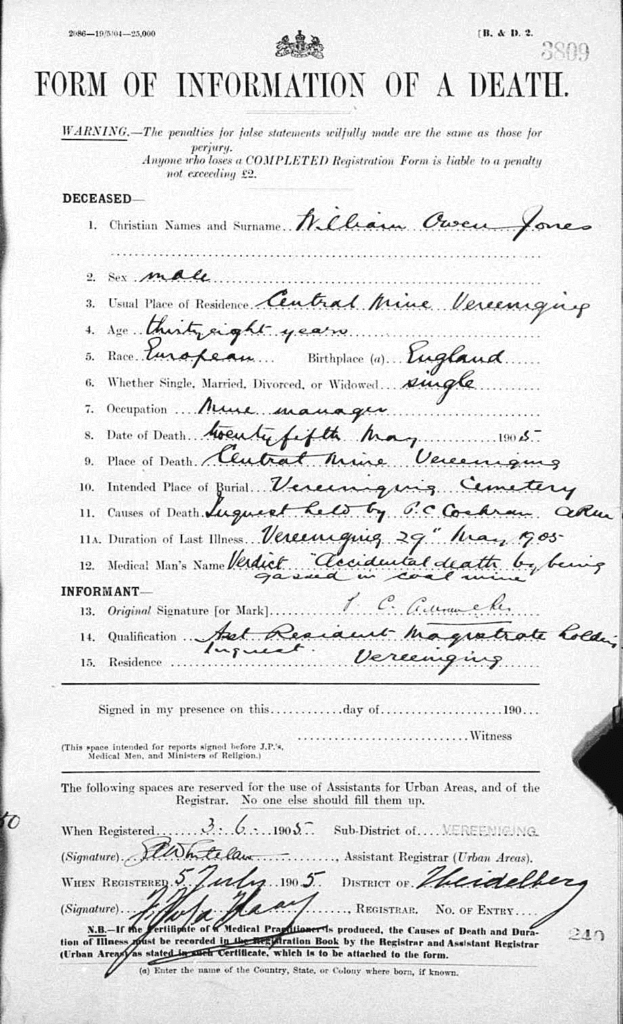
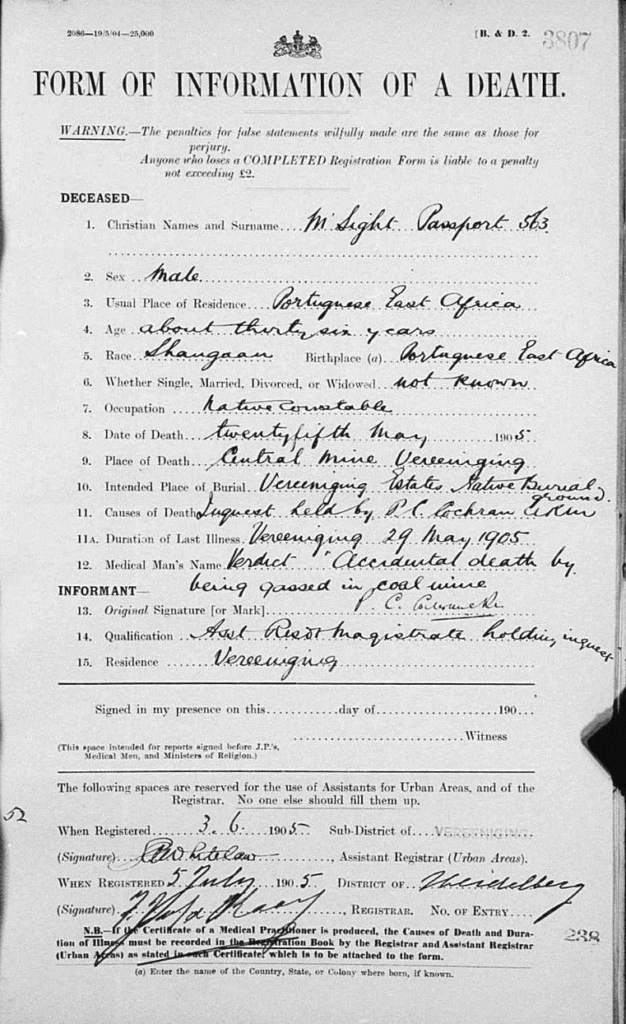
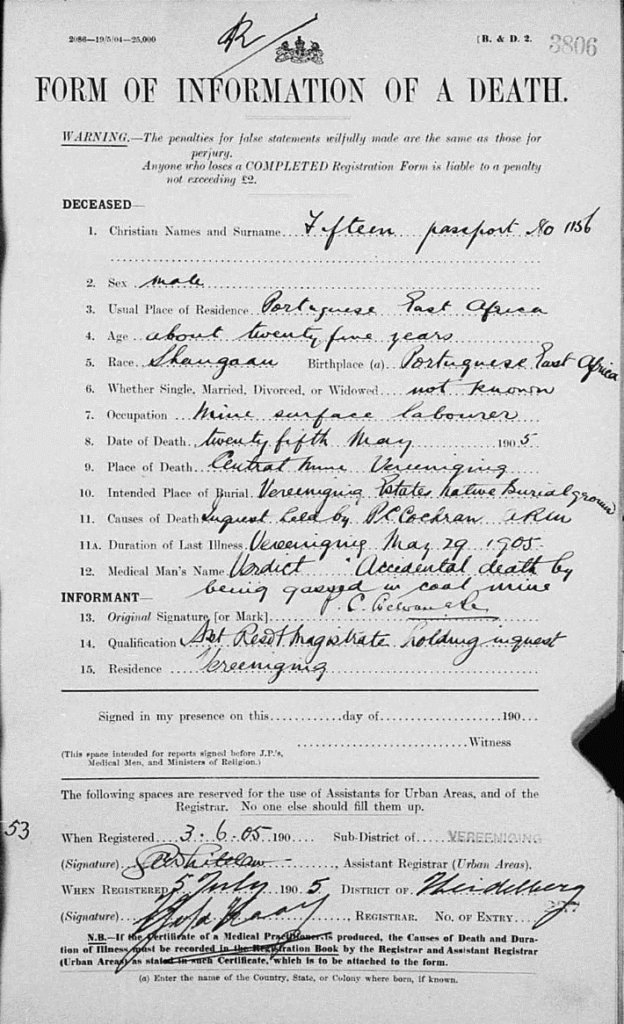
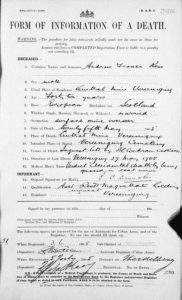
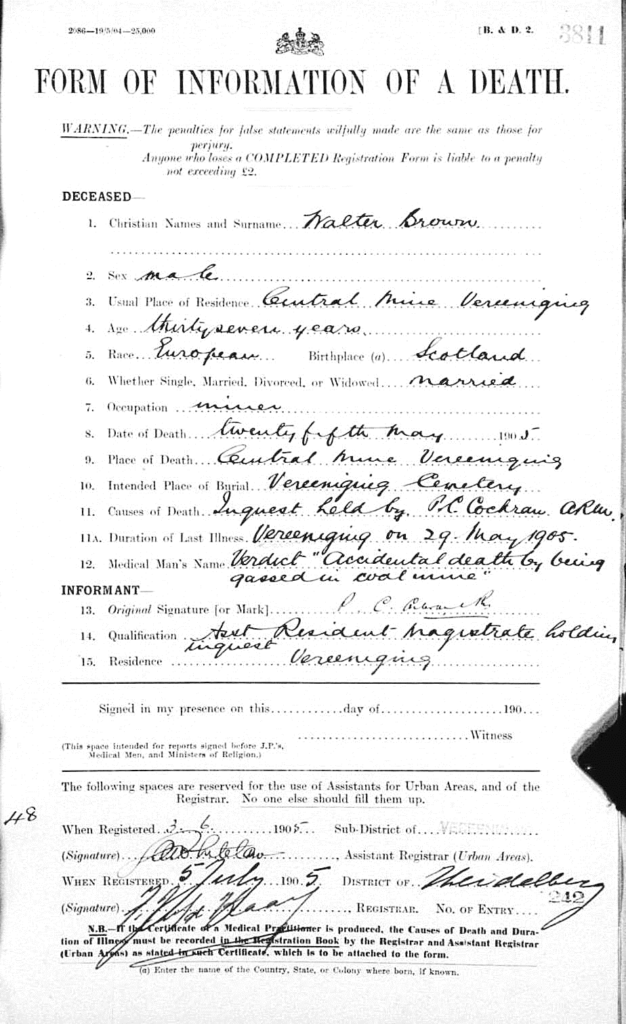
Andrew Fraser ROSS
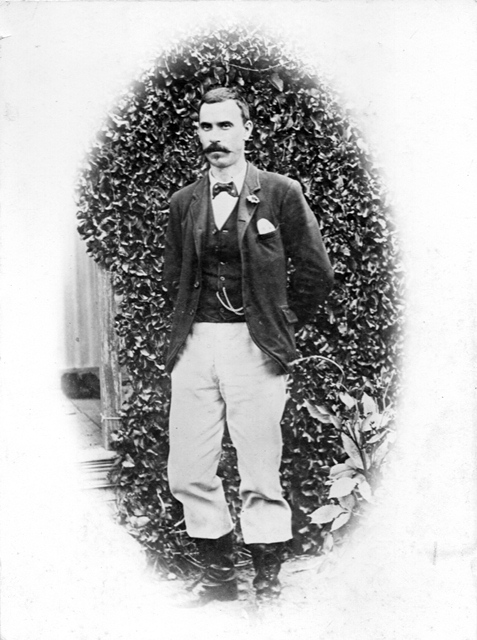
Catherine Frances Wessel(s) (ROSS)

1905
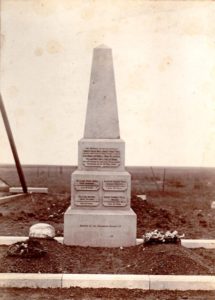
1918
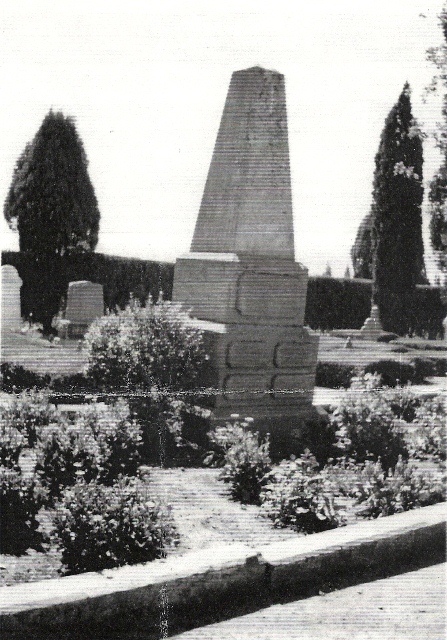
2004
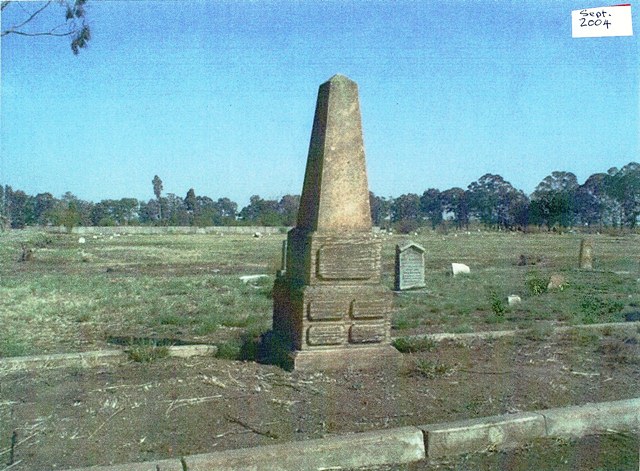
2010
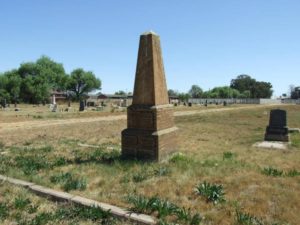
2012
